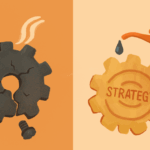If there’s one thing I’ve learned working in higher ed and talking with folks across this space, it’s that higher ed can be incredibly siloed. With lofty organizational goals, limited resources and constantly shifting priorities, it’s challenging for us as leaders to maintain a collaborative environment in large, complex teams.
I work in communications and marketing at Rutgers Business School in New Jersey with a team of 10. I’ve spent a lot of time thinking about, researching and working on team collaboration to help advance our goals and create a welcoming environment for team members.
There are three primary factors that I focus on to help foster collaboration: setting goals, encouraging open communication and leading by example.




